Evaluation on the Performance of Automobile Engine Using Air Injection Nozzle in the Intake Manifold
Abstract
1. Introduction
2. Modeling and Simulation Conditions
3. Experimental Setup and Method
3.1. Experimental Setup
3.2. Experimental Method
4. Results and Discussion
4.1. Simulation Results of the Intake Manifold Using a Nozzle
4.2. Experimental Results of Intake Manifold Using a Nozzle
5. Conclusions
- First, a flow simulation of the intake manifold using the nozzle was performed. Overall, the maximum velocity inside the intake manifold with a nozzle of 2.5 mm was higher than the case with a nozzle of 5 mm. The maximum velocity was highest at a nozzle angle of 30° for both intake manifolds with 2.5 and 5 mm diameter nozzles.
- An engine output performance test was conducted using vehicles with mileages of 30,000 and 180,000 km. When a 5 or 2.5 mm diameter nozzle was used for the vehicle with a mileage of 30,000 km, the engine outputs were improved by 4.7% and 6.5%, respectively, in comparison to the case when no nozzle was used. When a 5 or 2.5 mm diameter nozzle was used in the vehicle with a mileage of 180,000 km, the engine outputs were improved by 3.3% and 13.3%, respectively, compared to the case when no nozzle was used.
- As a result of measuring the exhaust gas emitted from the engine of the vehicle with a mileage of 30,000 km with an intake manifold in which a 5 or 2.5 mm diameter nozzle was installed, hydrocarbon emissions decreased by 39.3% and 45.8%, respectively, in comparison to the case when no nozzle was used, and carbon monoxide emissions decreased by 34.8% and 47.8%, respectively. In addition, when a 5 or 2.5 mm diameter nozzle was used for the vehicle with a mileage of 30,000 km, the nitrogen oxide emission greatly decreased by 53.8% and 71.9% compared to the case when no nozzle was used. When a 5 or 2.5 mm diameter nozzle was used for a vehicle with a mileage of 180,000 km, hydrocarbon emissions decreased by 38.4% and 50.5%, respectively, compared to the case when no nozzle was used, and carbon monoxide emissions decreased by 42.9% and 57.1%, respectively. In addition, nitrogen oxide emissions decreased by 27.1% and 37.2%, respectively.
- It was found that the use of a nozzle for the inflow of outside air improves the combustion speed by forming vortexes inside the intake manifold and, at the same time, forms a uniform combustion environment by increasing the degree of mixing, thereby improving the engine output and dramatically reducing harmful exhaust gases such as hydrocarbon, carbon monoxide, and nitrogen oxides, and the effect is greater for old vehicles in particular.
Author Contributions
Funding
Institutional Review Board Statement
Conflicts of Interest
Abbreviation
| ASM | Acceleration Simulation Mode |
| BTDC | Before top dead center |
| CO | Carbon monoxide |
| CO2 | Carbon dioxide |
| DOHC | Double overhead camshaft |
| GDI | Gasoline direct injection |
| NOx | Nitrogen oxides |
| HC | Hydrocarbon |
References
- Cho, Y.H.; Kim, S.O. EU, EURO 6 Enforcement of Automobile Exhaust Gas Regulation. Compliance in Advance and Supporting System, Korea, BSC Report 359-13-003, 2013; pp.1–6. Available online: http://madams.kr/newsa/130416.pdf (accessed on 14 December 2021).
- Choi, S.B.; Oh, B.Y.; Choi, D.M. Fire Patterns According to the Blood Hb-CO Concentration of Charred Bodies. J. Korean Inst. Fire Sci. Eng. 2012, 26, 40–48. [Google Scholar] [CrossRef]
- Chung, Y.J. Production of Carbon Monoxide and Carbon Dioxide Gases in the Combustion Tests. J. Korean Inst. Fire Sci. Eng. 2015, 29, 7–13. [Google Scholar] [CrossRef][Green Version]
- Mikołaj, M.; Maciej, K.J.; Agnieszka, W.; Olga, C.; Mateusz, K.; Mateusz, B.; Paweł, M.; Katarzyna, T.; Krzysztof, W.; Iwona, G.; et al. Influence of air pollution on exhaled carbon monoxide levels in smokers and non-smokers. A prospective cross-sectional study. Environ. Res. 2017, 152, 496–502. [Google Scholar] [CrossRef]
- Ma, Y.; Liu, A.; Egodawatta, P.; McGree, J.; Goonetilleke, A. Quantitative assessment of human health risk posed by polycyclic aromatic hydrocarbons in urban road dust. Sci. Total Environ. 2017, 575, 895–904. [Google Scholar] [CrossRef] [PubMed]
- Hussein, I.A.; Mona, S.M.M. A review on polycyclic aromatic hydrocarbons: Source, environmental impact, effect on human health and remediation. Egypt. J. Pet. 2016, 25, 107–123. [Google Scholar] [CrossRef]
- Kim, J.S.; Kim, Y.J.; Seo, C.W.; Park, T.W. Analysis of Test Results and Simulation Verification of Intake Manifold. In Proceedings of the Spring Conference of KSAE 2017, Jeju, Korea, 18–20 May 2017; KSAE17-S0091. pp. 199–208. [Google Scholar]
- Park, J.S.; Cho, J.G.; Song, S.H.; Cho, J.Y.; Wang, T.J. Evaluate the Effect of the Intake Manifold Geometry on Cylinder-to-cylinder Variation Using 1D-3D Coupling Analysis. Trans. KSAE 2016, 24, 161–168. [Google Scholar] [CrossRef]
- Kim, Y.B.; Na, C.K.R.; Lee, J.K.; Chu, D.H.; Kim, Y.H. A study on development of plastic intake manifold for gasoline T-GDi engine. In Proceedings of the KSAE Annual Conference 2013, Seoul, Korea, 20–23 November 2013; pp. 154–160. [Google Scholar]
- Kim, B.J.; Kim, S.T.; Ma, J.W.; Na, J.H. Analysis of Characteristics of Distributing Fluid Flow by Geometry of Manifold. In Proceedings of the KSME Fall Conference 2012, Changwon, Korea, 7–9 November 2012; pp. 2881–2882. [Google Scholar]
- Kim, J.S.; Kim, Y.J.; Kim, S.Y.; Park, T.W. A Study on the Loss Factor Characteristics of Intake Manifold Bell Mouse R. In Proceedings of the KSME CAE & Applied Mechanics Division Spring Conference 2017, Busan, Korea, 25–26 May 2017; pp. 355–359. [Google Scholar]
- Beatrice, C.; Belgiorno, G.; Blasio, G.D.; Mancaruso, E.; Sequino, L.; Vaglieco, B.M. Analysis of a Prototype High-Pressure “Hollow Cone Spray” Diesel Injector Performance in Optical and Metal Research Engines 2017-24-0073. In SAE Technical Paper; SAE: Warrendale, PA, USA, 2017. [Google Scholar] [CrossRef]
- Lee, J.W.; Park, T.S. Effect of Exit Shape on Turbulent Outflows in a Distribution Manifold. J. Comput. Fluids Eng. 2014, 19, 73–79. [Google Scholar] [CrossRef]
- Park, J.S.; Lee, K.S.; Song, S.H.; Chun, K.M. Optimization of Diesel Engine Performance with Dual Loop EGR considering Boost Pressure, Back Pressure, Start of Injection and Injection Mass. Trans. KSAE 2010, 18, 136–144. [Google Scholar]
- Zhang, P.; Zhang, J.; Li, Y.; Wu, Y. Nonlinear Active Disturbance Rejection Control of VGT-EGR System in Diesel Engines. Energies 2020, 13, 5331. [Google Scholar] [CrossRef]
- Bondar, V.; Aliukov, S.; Malozemov, A.; Das, A. Mathematical Model of Thermodynamic Processes in the Intake Manifold of a Diesel Engine with Fuel and Water Injection. Energies 2020, 13, 4315. [Google Scholar] [CrossRef]
- Shen, Z.; Cui, W.; Ju, X.; Liu, Z.; Wu, S.; Yang, J. Numeric Investigation of Gas Distribution in the Intake Manifold and Intake Ports of a Multi-Cylinder Diesel Engine Refined for Exhaust Gas Stratification. Energies 2017, 10, 1888. [Google Scholar] [CrossRef]
- Hwang, S.K.; Ko, A.H.; Yoon, J.W.; Myung, C.L.; Park, S.S.; Kim, E. A Study on NOx Reduction Characteristics of LNT Catalyst with Fuel Injection Control in Light-duty Diesel Engine. Trans. KSAE 2012, 20, 150–155. [Google Scholar] [CrossRef]
- Kwon, S.K.; Um, J.S.; Kang, E.J.; Seo, Y.H. Analysis the effects of fuel economy due to the test condition changes in gasoline vehicles. In Proceedings of the KSAE Annual Conference 2015, Gyeongju, Korea, 18–21 November 2015; pp. 203–206. [Google Scholar]
- Lee, S.H.; Lee, C.H.; Lee, J.W.; Lee, S.H.; Min, K.D.; Kim, S.W.; Lee, M.H. The effect of intake air temperature on NOx emissions in light-duty Diesel vehicle and engine. In Proceedings of the KSAE Annual Conference 2013, Seoul, Korea, 20–23 November 2013; pp. 126–128. [Google Scholar]
- Jang, J.H.; Kim, H.J.; Eom, M.D.; Park, S.W.; Chon, M.S. NOx emission characteristics of real driving emissions according to different driving area. In Proceedings of the KSAE Conference and Exhibition 2015, Gyeongju, Korea, 18–21 November 2015; p. 210. [Google Scholar]
- Alasfour, F.N. NOx emission from a spark ignition engine using 30% iso-butanol-gasoline blend: Part 2D-ignition timing. Appl. Therm. Eng. 1998, 18, 245–256. [Google Scholar] [CrossRef]
- Topgül, T.; Yücesu, H.S.; Çinar, C.; Koca, A. The effects of ethanol–unleaded gasoline blends and ignition timing on engine performance and exhaust emissions, Renew. Energy 2006, 31, 2534–2542. [Google Scholar] [CrossRef]
- Zsig, N.; Voser, C.; Onder, C.; Guzzella, L. Intake Manifold Boosting of Turbocharged Spark-Ignited Engines. Energies 2013, 6, 1746–1763. [Google Scholar] [CrossRef]
- Ashrafur Rahman, S.M.; Rizwanul Fattah, I.M.; Ong, H.C.; Zamri, M.F.M.A. State-of-the-Art of Strategies to Reduce Exhaust Emissions from Diesel Engine Vehicles. Energies 2021, 14, 1766. [Google Scholar] [CrossRef]
- Ashrafur Rahman, S.M.; Rizwanul Fattah, I.M.; Ong, H.C.; Ashik, F.R.; Hassan, M.M.; Murshed, M.T.; Imran, M.A.; Rahman, M.H.; Rahman, M.A.; Hasan, M.A.M.; et al. State-of-the-Art of Establishing Test Procedures for Real Driving Gaseous Emissions from Light- and Heavy-Duty Vehicles. Energies 2021, 14, 4195. [Google Scholar] [CrossRef]
- Sayin, C. The impact of varying spark timing at different octane numbers on the performance and emission characteristics in a gasoline engine. Fuel 2012, 97, 856–861. [Google Scholar] [CrossRef]
- Iodice, P.; Senatore, A.; Langella, G.; Amoresano, A. Effect of ethanol–gasoline blends on CO and HC emissions in last generation SI engines within the cold-start transient: An experimental investigation. Appl. Energy 2016, 179, 182–190. [Google Scholar] [CrossRef]
- Dardiotis, C.; Martini, G.; Marotta, A.; Manfredi, U. Low-temperature cold-start gaseous emissions of late technology passenger cars. Appl. Energy 2013, 111, 468–478. [Google Scholar] [CrossRef]
- Moon, S.; Huang, W.; Wang, J. Spray formation mechanism of diverging-tapered-hole GDI injector and its potentials for GDI engine applications. Fuel 2020, 207, 117519. [Google Scholar] [CrossRef]
- Wang, Q.; Xin, B.; Sun, P.; Li, J.; Liu, Q. Nonlinear compensation method for injector in small flow area on GDI engine. IFAC Pap. 2018, 51, 154–157. [Google Scholar] [CrossRef]
- Blasio, G.D.; Vassallo, A.; Pesce, F.C.; Beatrice, C.; Belgiorno, G.; Avolio, G. The Key Role of Advanced, Flexible Fuel Injection Systems to Match the Future CO2 Targets in an Ultra-Light Mid-Size Diesel Engine 2018-37-0005. In SAE Technical Paper; SAE: Warrendale, PA, USA, 2018. [Google Scholar] [CrossRef]
- Miganakallu, N.; Yang, Z.; Rogóż, R.; Kapusta, Ł.J.; Christensen, C.; Barros, S.; Naber, J. Effect of water-methanol blends on engine performance at borderline knock conditions in gasoline direct injection engines. Appl. Energy 2020, 264, 114750. [Google Scholar] [CrossRef]
- Ministry of Environment No. 2013-86. In Regulations on the Test Methods for Driving Vehicle Exhaust Gas Inspection; Ministry of Environment: Sejong, Korea, 5 July 2013.
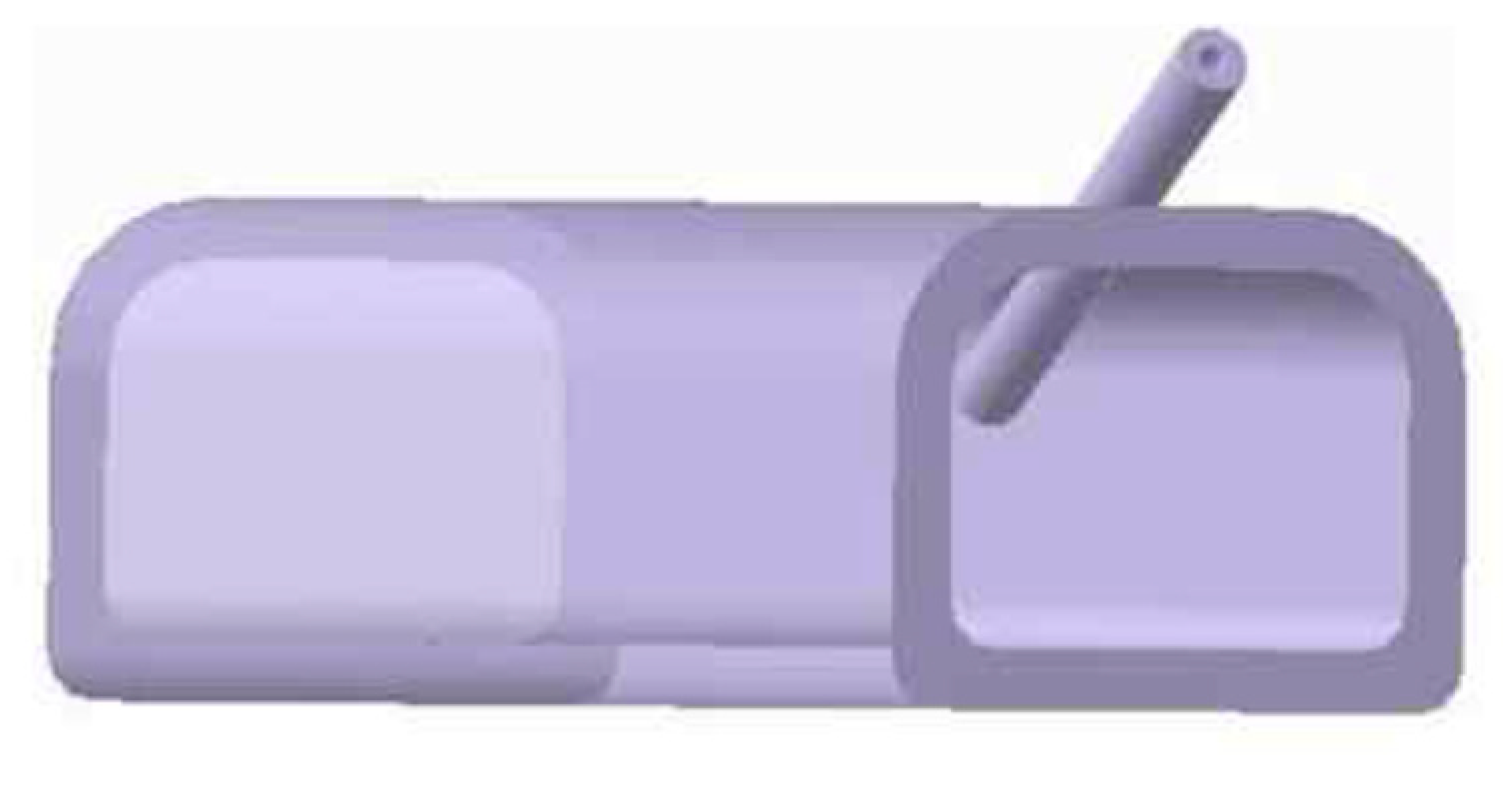
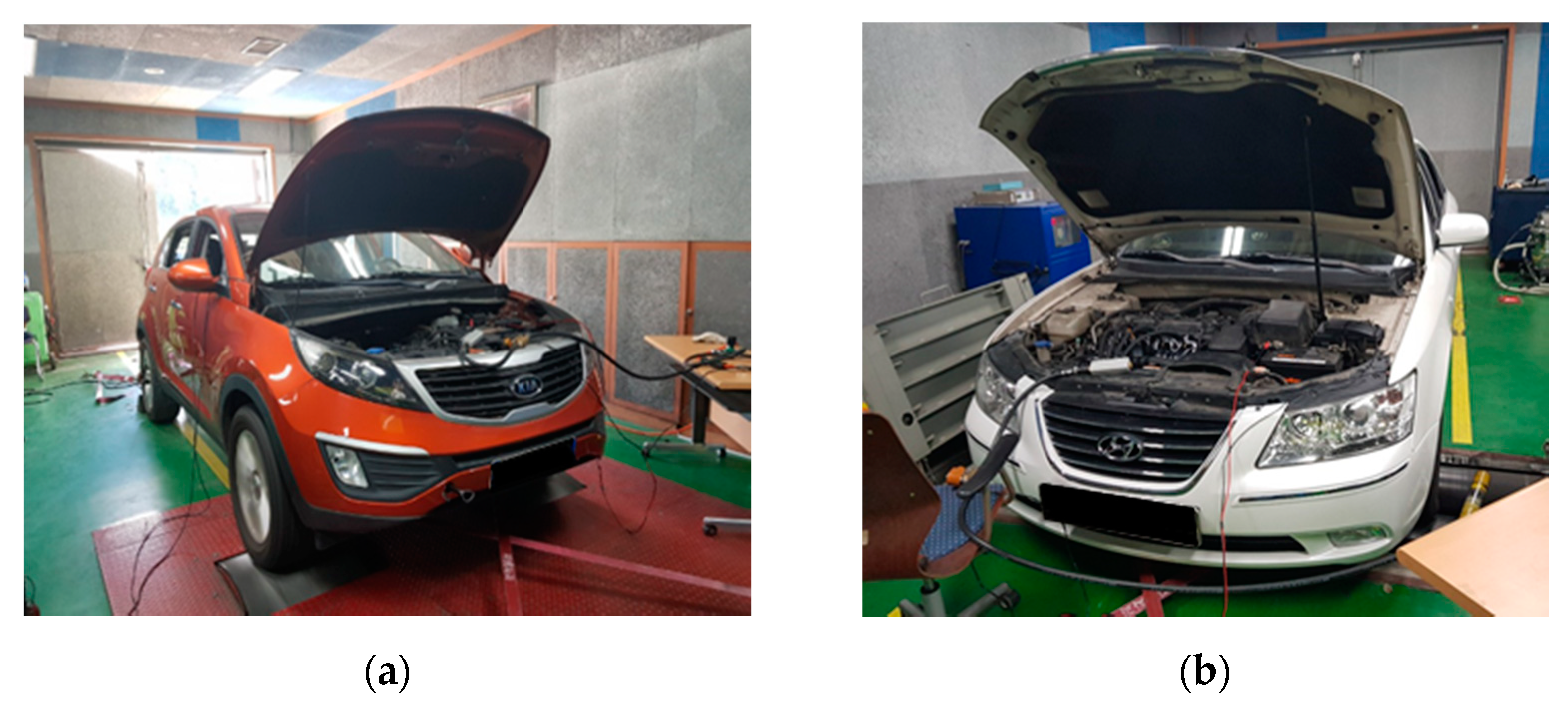

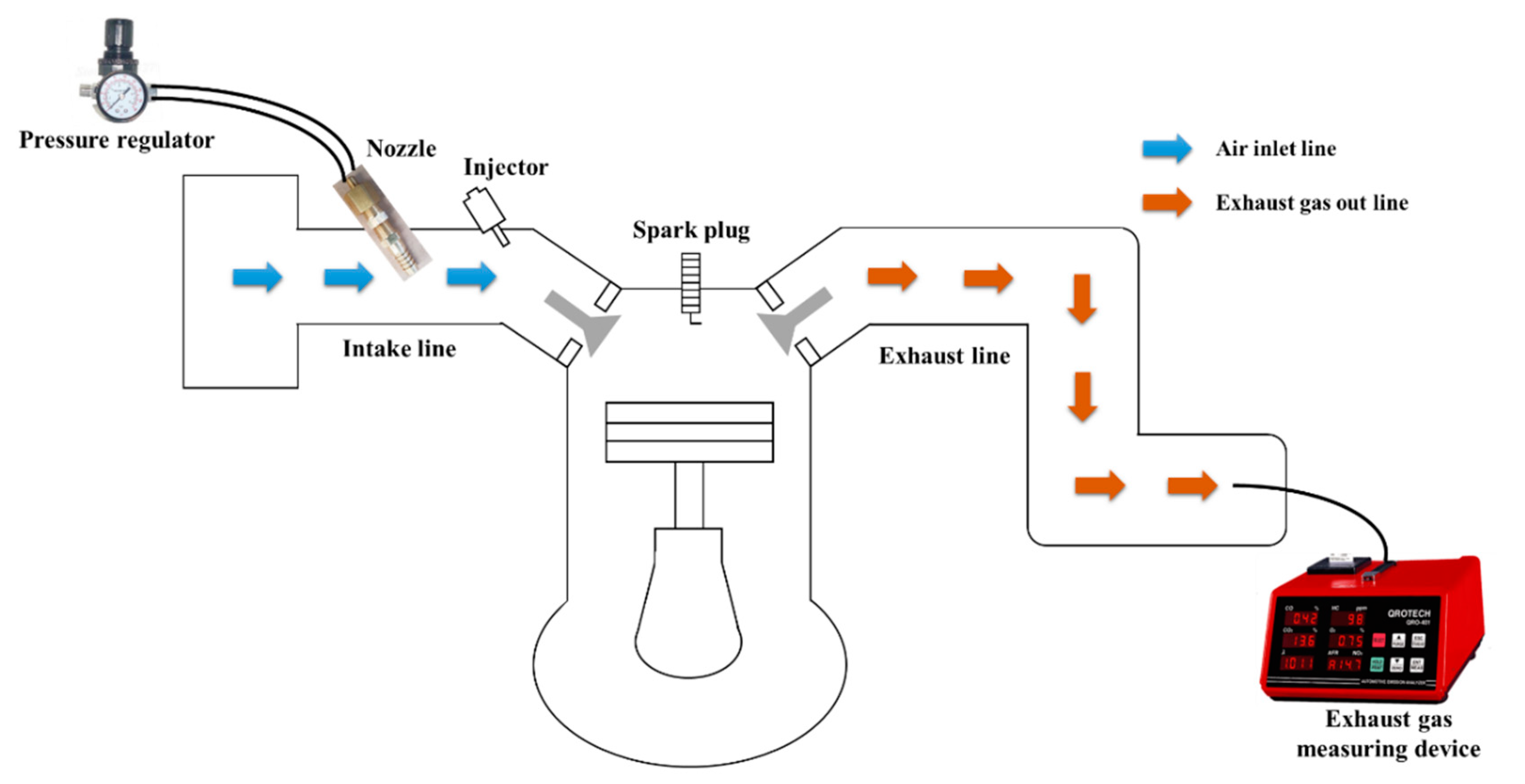

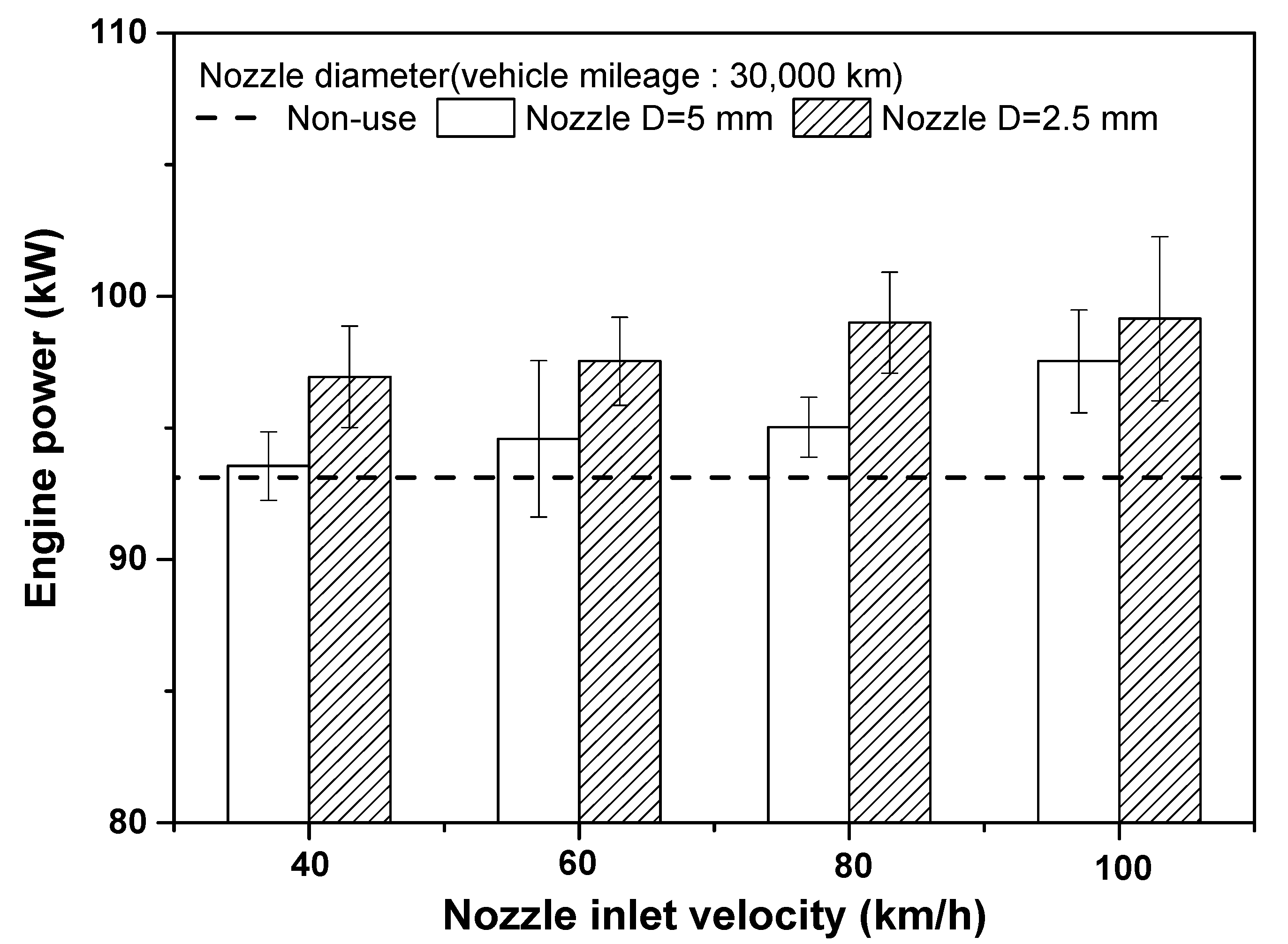
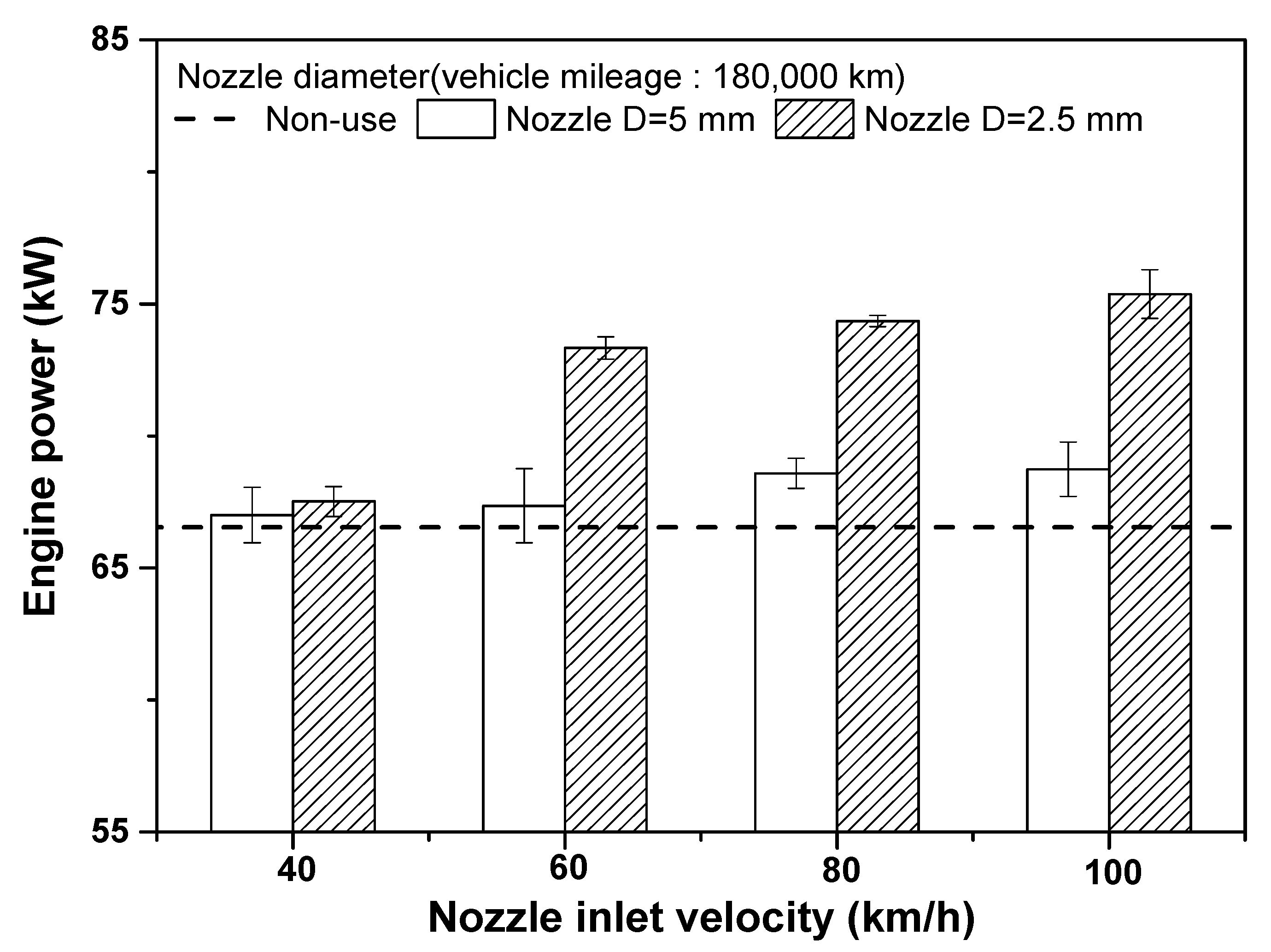

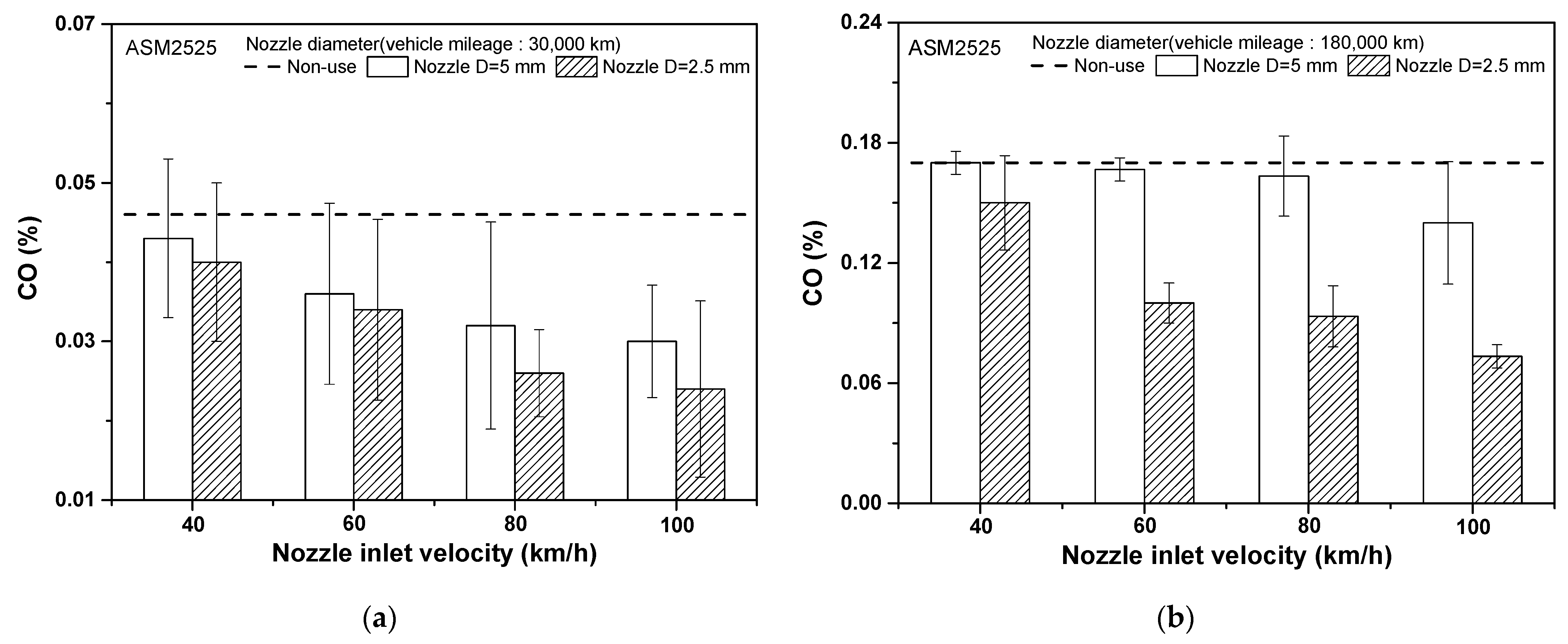

| Item | Specification |
|---|---|
| Working fluid | Ideal gas (air) |
| Nozzle diameter (mm) | 2.5, 5 |
| Nozzle inlet velocity (°) | 30, 45, 60, 75 |
| Nozzle inlet velocity (km/h) | 40, 60, 80 |
| Engine speed (rpm) | 2000 |
| Item | 30,000 km Engine | 180,000 km Engine |
|---|---|---|
| Model | Series DOHC Theta2 | Series DOHC |
| Displacement (cc) | 1998 | 1990 |
| Number of cylinders | 4 | 4 |
| Camshaft type | DOHC (4 Valve) | DOHC (4 Valve) |
| Compression ratio | 10.5 ± 0.3:1 | 10.5:1 |
| Inside diameter (mm) | 86 | 86 |
| Stroke (mm) | 86 | 86 |
| Idle (rpm) | 700 ± 100 | 700 ± 100 |
| Firing order | 1-3-4-2 | 1-3-4-2 |
| Description | Specification | |
|---|---|---|
| Lifter | Structure | Integral type |
| Operation method | Pneumatic type | |
| Pressure air | 6~10 bar | |
| Roller set | Maximum speed | 200 km/h |
| Roller diameter | 217.5 mm | |
| Roller surface | Powder coating | |
| General term | Operational voltage | 220 V or 380 V 50/60 Hz |
| Operational current | 16 A | |
| Allowable load | 5500 kg | |
| Maximum power | 367.75 kW (500 PS) | |
| Description | Item | Specification |
|---|---|---|
| Model | QRO-401 | |
| Range | CO | 0.00~9.99% vol |
| HC | 0.00~9.999 g/kg | |
| NOx | 0.00~5 g/kg | |
| CO2 | 0.00~25.00% vol | |
| Accuracy | CO | ±0.01% vol |
| HC | ±0.001 g/kg | |
| NOx | ±0.001 g/kg | |
| CO2 | ±0.1% vol | |
| Method of measurement | CO/HC | Nondispersive infrared rays |
| Response | 90% response within 10 s | |
| Item | Value |
|---|---|
| Nozzle diameter (mm) | 2.5, 5 |
| Nozzle injection angle (°) | 30 |
| Nozzle inlet velocity (km/h) | 40, 60, 80, 100 |
| Measured exhaust gas | HC, CO, NOx |
Publisher’s Note: MDPI stays neutral with regard to jurisdictional claims in published maps and institutional affiliations. |
© 2021 by the authors. Licensee MDPI, Basel, Switzerland. This article is an open access article distributed under the terms and conditions of the Creative Commons Attribution (CC BY) license (https://creativecommons.org/licenses/by/4.0/).
Share and Cite
Kim, T.; Shin, Y.; Park, J.; Cho, H. Evaluation on the Performance of Automobile Engine Using Air Injection Nozzle in the Intake Manifold. Energies 2021, 14, 8555. https://doi.org/10.3390/en14248555
Kim T, Shin Y, Park J, Cho H. Evaluation on the Performance of Automobile Engine Using Air Injection Nozzle in the Intake Manifold. Energies. 2021; 14(24):8555. https://doi.org/10.3390/en14248555
Chicago/Turabian StyleKim, Taejung, Yunchan Shin, Jungsoo Park, and Honghyun Cho. 2021. "Evaluation on the Performance of Automobile Engine Using Air Injection Nozzle in the Intake Manifold" Energies 14, no. 24: 8555. https://doi.org/10.3390/en14248555
APA StyleKim, T., Shin, Y., Park, J., & Cho, H. (2021). Evaluation on the Performance of Automobile Engine Using Air Injection Nozzle in the Intake Manifold. Energies, 14(24), 8555. https://doi.org/10.3390/en14248555






